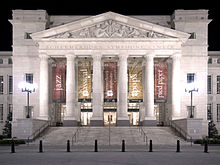Development

In Britain, architect Raymond Erith continued to design classical houses into the late 1960s and early 1970s. Quinlan Terry, a New Classical Architect who continues to practice, was an employee, later a partner and now the successor of the late Raymond Erith. In the late 1970s several young architects in Europe began challenging modernist proposals in architecture and planning. To broadcast them, Leon Krier and Maurice Culot founded the Archives d'Architecture Moderne in Brussels and began publishing texts and counterprojects to modernist proposals in architecture and planning. It received a boost from the sponsorship of Charles, Prince of Wales, especially with The Prince's Foundation for Building Community.
In these years, postmodern architecture developed a critique of modernist architectural aesthetics. Among them were certain influential postmodernist architects such as Charles Moore, Robert Venturi, and Michael Graves, who used classical elements as ironic motifs in order to criticize modernism's sterility. A broad spectrum of more than two dozen architects, theorists, and historians presented other alternatives to modernism. Among them were several serious New Classical architects who saw classicism as a legitimate mode of architectural expression, several of whom would later become Driehaus Prize Laureates, including some such as Thomas Beeby and Robert A.M. Stern, who practice both in post modern as well as classical modes. Some postmodernist firms, such as Stern and Albert, Righter, & Tittman, fully moved from postmodern design to new interpretations of traditional architecture. Thomas Gordon Smith, the 1979 Rome Prize laureate from the American Academy in Rome, was a devotee of Charles Moore. In 1988, Smith published "Classical Architecture - Rule and Invention", and, in 1989, was appointed to chair of the University of Notre Dame Department of Architecture, now the School of Architecture. Today, other programs exist which teach in part New Classical Architecture at the University of Miami, Judson University, Andrews University and beginning in 2013, the Center for Advanced Research in Traditional Architecture at the University of Colorado Denver.
Alongside these academic and scholarly developments, a populist and professional manifestation of new classicism has existed and continues to develop. The 1963 demolition of McKim, Mead & White's Pennsylvania Railroad Station in New York City provoked the formation of Classical America and its regional chapters, led by Henry Hope Reed, Jr.. Classical America advocated the appreciation of classically inspired buildings and for the practice of contemporary classical and traditional design by teaching architects to draw the classical orders, hosting walking tours, educational events, conferences and publishing The Classical America Series in Art and Architecture.
In 2002, the then-named Institute of Classical Architecture merged with Classical America to form the Institute of Classical Architecture & Classical America (now the Institute of Classical Architecture and Art). The ICAA currently supports and is supported by regional chapters across the United States, almost all of which host awards programs which recognize significant accomplishments in new classical and traditional design and construction. The ICAA publishes The Classicist, a peer-reviewed journal exclusively dedicated to the theory and practice of contemporary classicism in architecture, urbanism, and the allied arts. The ICAA offers educational programs to architecture and design professionals, many of which follow the methodologies of the École des Beaux-Arts. The ICAA also teaches courses to educate the general public, and has created programs such as the Beaux Arts Atelier, the Advanced Program in Residential Design for the American Institute of Building Designers, and many other unique programs.
The international character of the New Classical movement was propelled by the creation in 2001 of the International Network for Traditional Building, Architecture & Urbanism (INTBAU), an international organization dedicated on supporting traditional building and the maintenance of local character. INTBAU has over 30 local chapters, which include countries like Albania, Afghanistan, Australia, Bangladesh, Canada, China, Cuba, Cyprus, Czechia, Estonia, Finland, Germany, India, Iran, Ireland, Italy, Malaysia, Montenegro, the Netherlands, New Zealand, Nigeria, Pakistan, the Philippines, Poland, Portugal, Romania, Russia, Spain, Sweden, Turkey and the USA. This network was created under the patronage of Charles, Prince of Wales himself an important figure in the New Classical movement.
In 2003, Chicago philanthropist Richard H. Driehaus established a prize in architecture to be given to an architect "whose work embodies the principles of classical and traditional architecture and urbanism in society, and creates a positive, long lasting impact." Awarded by the University of Notre Dame School of Architecture, the Driehaus Architecture Prize is seen as the alternative to the modernist Pritzker Prize. The Driehaus Prize is given in conjunction with the Reed Award, for an individual working outside the practice of architecture who has supported the cultivation of the traditional city, its architecture and art through writing, planning or promotion. Other high-profiled classical architecture awards are the US-American Palladio Award,, the Iberian Rafael Manzano Prize, the Edmund N. Bacon Prize, and the Rieger Graham Prize of the Institute of Classical Architecture and Art (ICAA) for architecture graduates.
Comments
Post a Comment